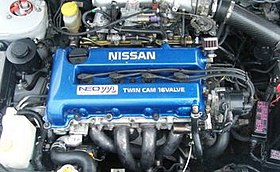This article relies largely or entirely on a single source. (November 2018) |
| Nissan SR engine | |
|---|---|
 Nissan SR16VE engine | |
| Overview | |
| Manufacturer | Nissan (Nissan Techno) |
| Production | 1987–2007 |
| Layout | |
| Configuration | Inline-four engine |
| Displacement | 1.6 L (1,596 cc) 1.8 L (1,838 cc) 2.0 L (1,998 cc) |
| Cylinder bore | 82.5 mm (3.25 in) 86 mm (3.39 in) |
| Piston stroke | 68.7 mm (2.70 in) 86 mm (3.39 in) |
| Cylinder block material | Aluminum[1] |
| Cylinder head material | Aluminum[1] |
| Valvetrain | DOHC 4 valves x cyl. with VVT (some versions) |
| Compression ratio | 9.0:1, 9.5:1, 10.3:1, 11.0:1 |
| Combustion | |
| Turbocharger | Garrett T25G or T28 (some versions) |
| Fuel system | Fuel injection |
| Fuel type | Gasoline |
| Cooling system | Water-cooled |
| Output | |
| Power output | From 110 PS (81 kW; 108 hp) to 320 PS (235 kW; 316 hp) |
| Torque output | From 150 N⋅m (111 lb⋅ft) to 418 N⋅m (308 lb⋅ft) |
| Chronology | |
| Predecessor | Nissan CA engine |
| Successor | Nissan QG engine Nissan QR engine Nissan MR engine |
The SR engine is a series of 1.6 L (1,596 cc), 1.8 L (1,838 cc) or 2.0 L (1,998 cc) straight-four, four-stroke gasoline engines manufactured by Nissan. It has an aluminium head and block with steel sleeves and has a DOHC 4-valve design, with variable valve timing on select models. It was added to a new engine family name PLASMA (Powerful & Economic, Lightweight, Accurate, Silent, Mighty, Advanced).
The engine was used in many small to medium Nissan vehicles, including high-performance turbocharged variants. It was designed by Nissan as a replacement of the earlier CA series of engines, and was replaced by the QR and MR series of engines. Power outputs are shown under JIS Net PS or ECE Net kilowatts unless otherwise indicated.
- ^ a b "The SR20DET". 31 August 2018.
